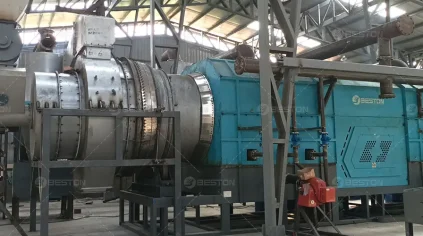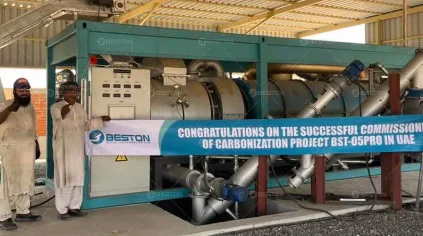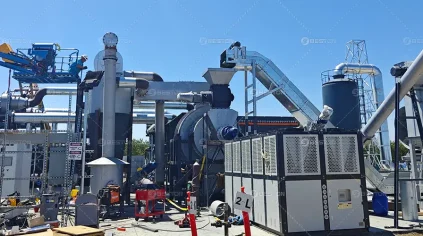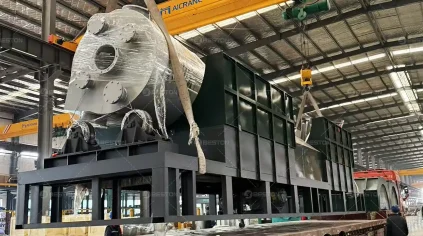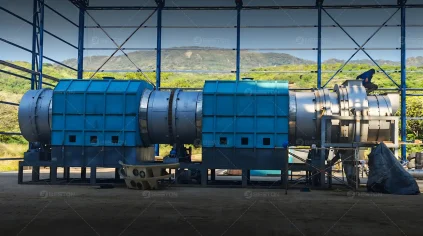
Biochar pyrolysis equipment (BST-50S Model) has been evaluated by Puro.earth. It efficiently converts biomass into EBC-grade biochar through high-temperature and oxygen-free pyrolysis. The final biochar finds applications in industrial smelting, agricultural fertilizers, and alternative fuels, among others. This provides effective solutions for waste reduction and resource utilization across various industries. Contact Beston Group to get a customized solution.
What Is Biochar Pyrolysis Equipment?
A biochar pyrolysis machine is the cornerstone of biomass-to-biochar conversion. It provides a high-temperature, oxygen-free environment that ensures efficient processing. This enables optimal biomass utilization and stable production of high-quality biochar.

Control Pyrolysis Conditions Precisely
The quality of biochar largely depends on the pyrolysis conditions. Advanced biochar production equipment can regulate the two necessary conditions:
- High-temperature Control: Pyrolysis generally occurs at 300–600°C. Different temperature ranges affect the degree of carbonization and biochar’s suitability for specific applications.
- Oxygen-Free Environment: By isolating oxygen, the machine stops biomass from burning and turns it into high-quality biochar.
Enhance Biochar Quality
High-quality biochar is essential for applications such as soil improvement, carbon removal. Advanced biochar pyrolysis machine helps optimize its characteristics:
- Retent Beneficial Carbon Structures: The controlled environment preserves the stable, carbon-rich structure and porosity of biochar, enhancing its functionality, such as water retention, adsorptivity.
- Reduce Ash and Impurities: Properly managed pyrolysis minimizes undesirable by-products, ensuring that the final biochar is of high purity and suitable for advanced applications.
Parameters of Biochar Pyrolysis Equipment for Sale
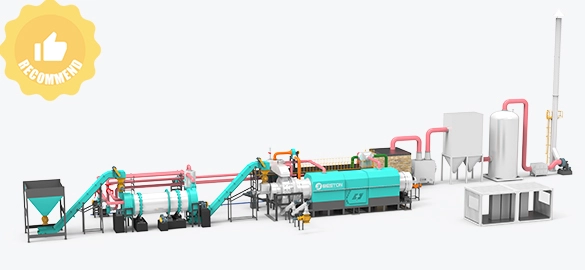
BST-50S Model
- BST-50S technology vetted by puro.earth
- 6,000 tons biochar production annually
- 7200H/Y stable & safe operation
- 4 Configuration options
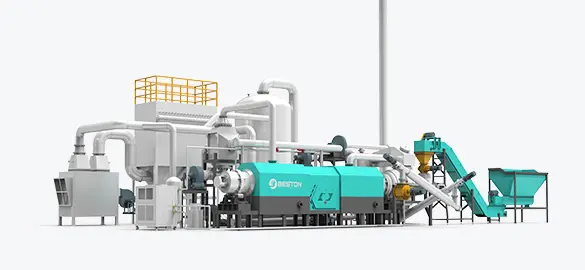
BST-06 Model
- 8000H/Y stable & safe operation
- Low-cost carbon removal process verification
- Small-scale test machine
- 2 Configuration options
| Model | BST-50 Standard | BST-50S LM | BST-50S HM | BST-50S MAX | BST-06 Standard | BST-06MAX |
|---|---|---|---|---|---|---|
| Time to Market | 2015 | 2022 | 2022 | 2022 | 2025 | 2025 |
| Operating Mode | Continuous | Continuous | Continuous | Continuous | Continuous | Continuous |
| Application | Commercial Scale | Commercial Scale | Commercial Scale | Commercial Scale | Testing | Testing |
| Dust Removal System | Standard | Advanced | Advanced | Advanced | Standard | Advanced |
| Feeding Capacity | 10-15m³/h | 10-15m³/h | 10-15m³/h | 10-15m³/h | 100-300KG/H | 100-300KG/H |
| Biochar Discharge Temperature | 45℃ | 45℃ | 45℃ | 45℃ | 45℃ | 45℃ |
| Puro.earth Authentication Model | × | √ | √ | √ | × | |
| Maximum Pyrolysis temperature | 650℃ | 650℃ | 650℃ | 850℃ | 650℃ | |
| Service Life | 5-8 years | 5-8 years | 5-8 years | 8-10 years | 5-8 years | |
| Annual Operating Time | 7200 hours | 7200 hours | 7200 hours | 7200 hours | 8000 hours | |
| Land Space Required (L*W*H*m) | 35m×15m×8m | 65m×15m×8m | 65m×15m×8m | 65m×15m×8m | 25m*18m*6m | |
| Total Power (KW) | 201.25kW | 453.35kW | 505.35kW | 505.35kW | 129.79 | 162.79 |
| Cooling Method | Recycling cooling Water | Industrial chiller | Industrial chiller | Industrial chiller | Recycling cooling Water | Industrial chiller |
| Installation Period (Calendar Days) | 50 | 70 | 70 | 70 | 45 | 50 |
BST-50S Biochar Pyrolysis Machine: Puro.earth Authentication Model
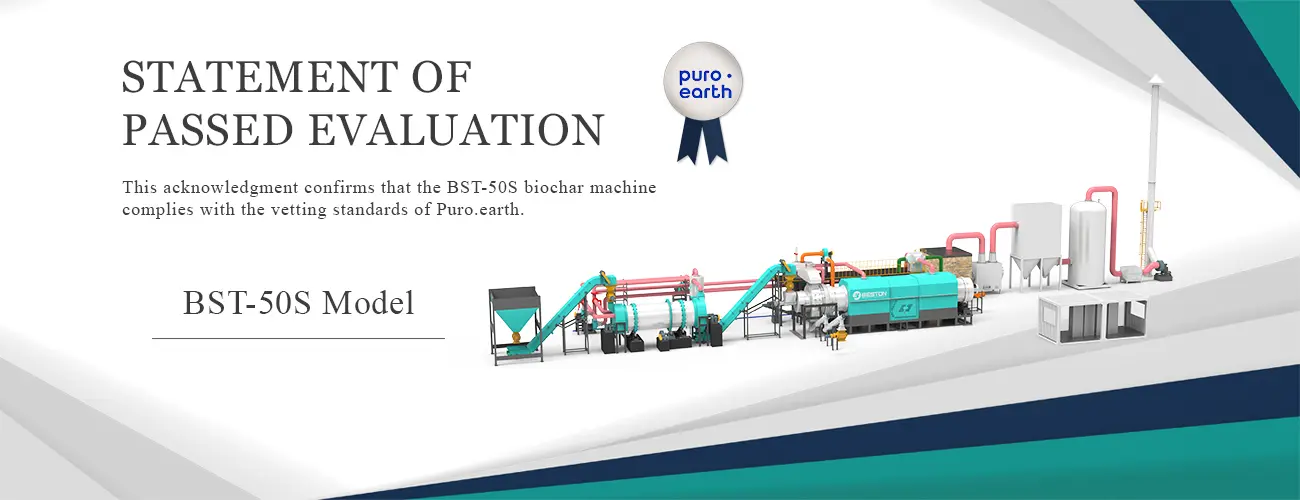
Emissions Comply with Standards
Our BST-50S biochar pyrolysis equipment has been vetted that it ensures
- low emissions of air pollutants
- safe disposal of any waste stream
- quantifiable greenhouse gas data
Biochar Quality Meets Standards
It has been vetted that biochar produced by our BST-50S biomass pyrolysis plant meets the EBC quality standards. The test data includes:
- H/Corg <0.7
- heavy metal content
- total 8 EFSA-PAH
Technology Meets CDR Standards
With Puro.earth evaluation, our BST-50S machine is qualified for the global carbon removal (CDR) market. It offers compliant biochar production technology to support carbon removal project and contribute to carbon neutrality goals.
BST-50S Model: Annual 6000 Tons Biochar = 12000 Tons CO₂ Locked

Tar and Dust Self-Cleaning System
- Stable operation 7,200 h/year: Self-cleaning of tar and dust prevents blockages and heat exchange loss, extending trouble-free operation.
- Consistently high biochar quality: Less tar buildup avoids uneven heat transfer, ensuring consistent biochar quality.
- Easier environmental compliance: This technology prevents tar and dust emissions from the biochar pyrolysis machine, supporting compliance with emission and waste disposal standards.
Double-cylinder Rotary Reactor
- Enhanced Capacity & Space Utilization: The dual-cylinder design allows BST-50 to process over 10 m³ per hour within the same footprint.
- Staged Carbonization & High-Quality Biochar: The inner cylinder ensures drying, while the outer cylinder enables high-temperature carbonization, producing biochar that meets EBC standards.
- Improved Heat Transfer: The rotary core structure continuously tumbles biomass, reducing sticking and local overheating.
Find EBC Biochar Test Report: Key Indicators Analysis
The biochar produced by Beson biochar pyrolysis equipment meets EBC standards, ensuring strong market acceptance. This makes the investment promising, with significant potential for economic returns.

| Load capacity | EBC Standard | German Laboratory | Chinese Laboratory |
|---|---|---|---|
| H/C Molar Ratio | <0.4 – 0.7 | 0.45 (Generally Meets All Application Standards) | 0.11 – 0.32 |
| Heavy Metal | Depends on Specific Application | Fully Meet All | Fully Meet All |
| PAHS-8 | Depends on Specific Application | Fully Meet All | / |
| PAHS-16 | <6 mg/kg | Compliant with EBC-Feed, Urban, Basic Material Slightly above EBC Feed-Plus, Agro-Bio, Agro | 0.2 mg/kg |
H/C Molar Ratio
- Significance: Reflects the aromaticity and stability of biochar. Lower H/C ratios indicate higher carbonization and more stable structure, suitable for long-term carbon sequestration and soil improvement.
- Interpretation: Biochar with H/C < 0.4–0.7 generally exhibits high persistence and environmental stability.
Heavy Metals
- Significance: Refers to Pb, Cd, Hg, As, Cr, etc., in biochar. Excessive amounts pose environmental and health risks.
- Interpretation: Biochar must meet strict heavy metal limits, especially for agricultural or feed-grade applications, to prevent secondary pollution.
PAHs-8
- Significance: Refers to 8 key polycyclic aromatic hydrocarbons formed during pyrolysis, which are harmful to humans and the environment.
- Interpretation: PAH levels must be strictly controlled in agricultural and environmental applications to avoid soil or food chain contamination.
PAHs-16
- Significance: Covers 16 priority PAHs, widely used in international environmental monitoring.
- Interpretation: <6 mg/kg is the EBC hard limit, ensuring biochar is environmentally safe.
Biochar in Action: Key Applications

Carbon Removal
Biochar sequesters carbon in the soil for hundreds of years, combating global warming. Investors can earn carbon credits to trade: 1 Ton Biochar ≈ 2-2.5 CDR Credit, 1 CDR Credit ≈ $150-250.
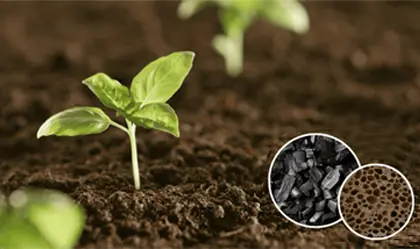
Agriculture Soil Improvement
Biochar can improve soil nutrients, structure, drainage capacity, and pH value. It is a good soil conditioner.
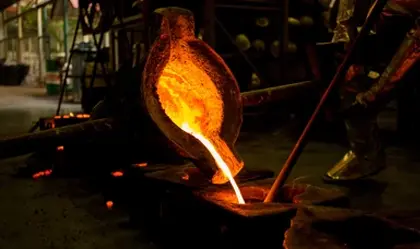
Reducing Agent in Metallurgy
Used in smelting processes, biochar can reduce impurity formation and improve the purity and quality of metals.

Construction Materials
Biochar can be incorporated with other materials to produce concrete, bricks, and other building products.

Animal Husbandry
Adding biochar to animal feed or using it in barns improves digestion, enhances living conditions, and reduces ammonia emissions.

Alternative Fuel
You can use biochar as an alternative industrial fuel in various factories. Or you can apply it as BBQ charcoal and hookah charcoal.
Biochar Pyrolysis Process: Equipment Workflow
01 Pretreatment
Key requirements:
- Moisture content < 15%
- 5 mm < Particle size < 20 mm
- Pourable and free-flowing
02 Feeding
Input the biomass into the biochar pyrolysis reactor. A screw feeder efficiently transports the biomass that meets the feeding requirements into the inner cylinder of the reactor.
03 Pyrolysis
04 Syngas Recycling
05 Cooling Discharging
06 Exhaust Gas Treatment
Customer Case Studies of Biochar Pyrolysis Equipment
Biochar Pyrolysis Equipment: Bring Value to Various Industries
Biochar pyrolysis machine helps to address waste management, energy needs, and environmental concerns across various industries. As sustainability and environmental awareness rise, the demand for this solution is expected to grow across multiple sectors.

Forestry and Wood Processing Industry
- Waste Utilization: Biochar pyrolysis technology reuses wood waste generated from forestry operations and sawmills to reduce environmental challenges and increase added value.
- Climate Benefit Potential: Biochar made from woody biomass is more stable than that from herbaceous biomass; once incorporated into soil, it can sequester carbon for the long term, helping mitigate climate change.
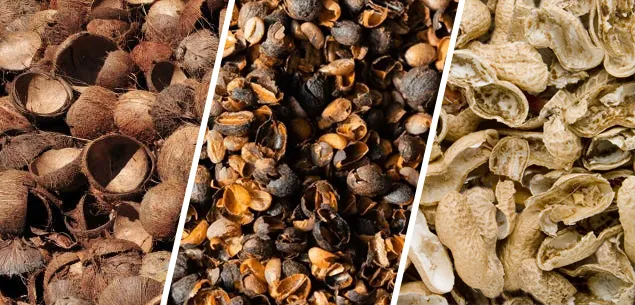
Food Processing Industry
- Waste Utilization: Fruit peels, shells, and crop residues can be converted into stable carbon-rich biochar through pyrolysis, achieving waste reduction and high-value utilization.
- Value Chain Extension: The resulting biochar can be used for soil improvement, animal feed additives, or activated carbon production, extending the food processing value chain and enhancing economic benefits.

Agriculture Planting Industry
- Crop Residue Management: Biochar Pyrolysis reduces open burning of crop residues, helping to lower air pollution and greenhouse gas emissions.
- Soil Health Improvement: Returning biochar to the field improves soil properties, enhances soil fertility, and promotes sustainable agricultural development.
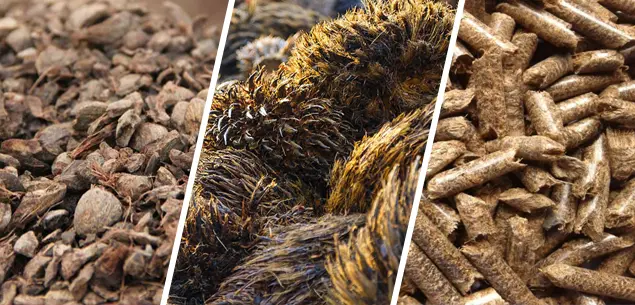
Palm Industry
- Waste Reduction: Biochar pyrolysis offers a new solution for the reduction of empty fruit bunches (EFB), alleviating the pressure caused by their large-scale accumulation.
- Industry Sustainability: Biochar can be reintegrated into palm plantations to improve soil conditions and promote crop growth, supporting the sustainable development of the palm oil industry.
Start Biochar Pyrolysis Business
Choose Beston Group for advanced technology and premium service—your fast track into the thriving biochar market! Our expert team is ready to assist you every step of the way. Contact us now for more details! We’ll customize the best biochar pyrolysis equipment just for you! Welcome to subscribe to our YouTube, LinkedIn, Facebook, and Pinterest channels!

